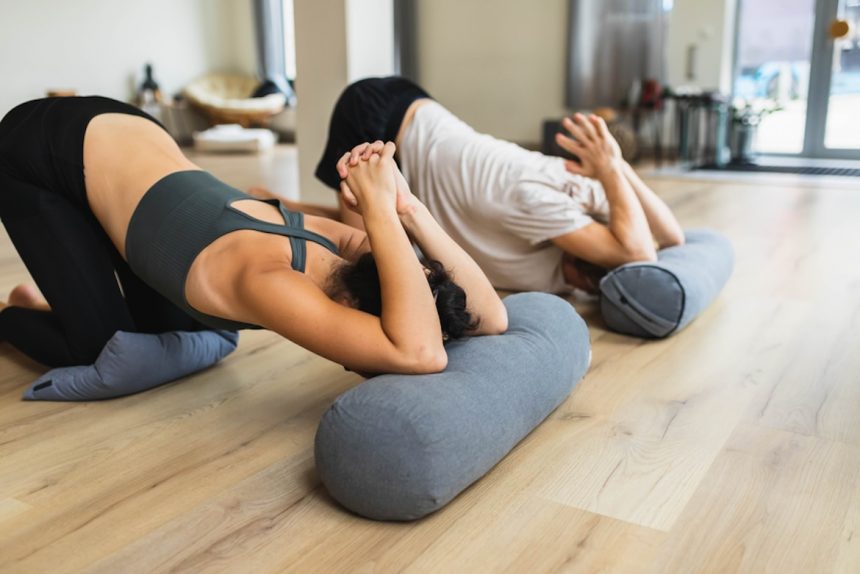We use our shoulders for just about every little thing we do: reaching for a can in the back of the cabinet; putting a book on a high shelf; slipping our arm into a sleeve; brushing our teeth. So when you have a bum shoulder, it’s, well, a big bummer. Most people with shoulder pain have some kind of rotator cuff tear or injury. Problems with the rotator cuff—one of the most important parts of the shoulder—are super common (more on why later). Every year, more than 2 million Americans see their doctor complaining of rotator cuff pain, according to the Cleveland Clinic. While preventing a rotator cuff injury isn’t always possible, showing your shoulder some love in the form of daily rotator cuff stretches can certainly lower your chances. Read on to learn more about the rotator cuff, including why it’s prone to pain, the best stretches to keep it long and limber, and what to do if you end up with an injury.
What is the rotator cuff, exactly? “The rotator cuff is a group of relatively small muscles [and tendons] that attach to the front and the back of the shoulder,” says Anna Hammond, DPT, OCS, PCES, a physical therapist at Core Exercise Solutions. “The shoulder joint is a ball and socket joint,” so the rotator cuff muscles “work together to help keep the ball centered in the socket,” Hammond says. In other words, it holds your shoulder in place and stabilizes the joint, so you can do things like lift your arms or reach overhead.
Why is the rotator cuff prone to injury? “The short answer is most people have tight or weak rotator cuff muscles,” says Grayson Wickham, DPT, CSCS, founder of the Movement Vault. Typically, tight rotator cuff muscles on the front of the shoulder (including the pectoralis minor) will pull the shoulders forward (i.e., out of proper alignment), he says. The rotator cuff muscles on the back of the shoulder can also be weak or unstable. This lack of stability usually has to do with repeated poor posture (think: slumping in front of a laptop nine hours a day), Wickham says. Not actively stretching or strengthening the muscles also plays a part. Problem is, poor shoulder mobility and stability sets off a damaging domino effect, something Wickham calls the “joint pain and injury cycle.”
The cycle is:
- Tight or unstable shoulder muscles cause compensations in your rotator cuff
- These compensations lead to joint wear-and-tear (in this case, micro-tearing of specific rotator cuff muscles such as your supraspinatus)
- This joint wear-and-tear eventually leads to pain and injury
Making matters worse, we depend on the rotator cuff for a lot of everyday movements (think: combing our hair, pushing a vacuum) so it gets a lot of wear-and-tear. Over time, this overuse damages and weakens the shoulder, making it even more susceptible to injury, according to Harvard Health Publishing. On top of all this, the movement of the rotator cuff involves the sequencing of many muscles including the scapula (shoulder blade), the humerus (upper arm bone), and the rib cage, Hammond says. “If one component isn’t working well, the rotator cuff can easily get pinched in the joint space or set up to overwork,” she says.
How to know if you have a rotator cuff injury Tears are one of the most common rotator cuff injuries. They can happen accidentally, say, if you fall, or they can be a byproduct of wear-and-tear from repetitive activities and regular aging. Symptoms of a rotator cuff tear include, per the Cleveland Clinic:
- Difficulty raising or moving your arm without pain or discomfort
- General weakness in your shoulder joint
- Less range of motion in your shoulder
Tendonitis (or inflammation of tendons in the shoulder) is another common rotator cuff problem. When it’s severe, tendonitis can even cause a rotator cuff tear. Symptoms of rotator cuff tendonitis include, per Harvard Health Publishing:
- A dull ache around the outside tip of the shoulder that gets worse when you push, pull, reach overhead, or lift your arm up to the side
- Pain when you lie on the affected shoulder
Can rotator cuff stretches prevent an injury? The short answer: yes, in part. “The most effective way to prevent rotator cuff injuries is to improve your overall shoulder mobility and stability,” Wickham says. This means making sure the muscles on the front and back of your shoulder are strong and flexible. Targeted stretching is part of this equation. “An effective shoulder mobility program will include specific rotator cuff active stretches,” Wickham says. The key word being active. “Static stretching will not improve your rotator cuff range of motion or stability,” he says. The other pivotal piece for preventing a rotator cuff injury is strengthening the shoulder muscles. Muscle activation exercises will help enhance rotator cuff mobility and stability, specifically with overhead movements, Wickham says.
Hammond agrees: “it’s about a well-balanced weight training program that helps make sure your scapula moves well in all planes of motion and with control.” “Typically, focus on rib cage mobility and eccentric lengthening exercises of the serratus, pecs, lats, and subscap,” Hammond says. “The eccentric focus of an exercise helps give you length and strength” in these muscles, she says. Both are necessary for staying injury free.
Other benefits of rotator cuff stretches “In addition to injury prevention, performing rotator cuff active stretches and muscle activations will also improve your performance in your daily life activities,” Wickham says. A few everyday things you can do with more ease (and less pain) when your rotator cuff is in tip-top shape: Reach high in your cupboard to get something Open a door Lift your groceries Brush your hair Adding rotator cuff stretches to your regular routine can also level up your fitness in the gym or in your sport, Wickham says. You’ll be better at push-ups, bench press, pull-ups, throwing a baseball or football, or swinging a tennis racket, just to name a few.
Best rotator cuff stretches to prevent injury These shoulder exercises, which you can do at home, are recommended by Wickham to build range of motion and flexibility, and improve stability and mobility within the shoulder joint to help prevent injury in your rotator cuff. For the best results, incorporate them into a well-balanced strength-training routine.
- Rotator Cuff Muscle and Fascia Active Release Lying With Ball
- Sleeper Stretch Active Stretch
This targets and unlocks your posterior rotator cuff muscles (the ones in the back) by decreasing neurologic muscle tone, Wickham says. We like to use a Trigger Point Massage Ball for fascia stretches, but a lacrosse or even tennis ball will work just as well. Start by lying on your back with one arm lifted straight overhead. Place the mobility ball on your rotator cuff muscles of your overhead arm. To find these muscles, take your opposite hand and reach over your shoulder to find the spine of your shoulder blade. Place the ball underneath this spine. The ball should be on the bottom half of your shoulder blade. Internally and externally rotate your shoulder. To do this, point your thumb upward toward the ceiling, and then rotate your shoulder, pointing your thumb downward as far as you can toward the ground. You can also explore other areas on your rotator cuff by moving the ball slightly in either direction. Continue this shoulder rotation movement while lying on the ball for 2 minutes. Switch and repeat on your other shoulder.
“This active stretch and activation exercise targets the back of your shoulder,” Wickham says. “It maximally stretches and activates your posterior rotator cuff muscles and improves shoulder rotation.” Start by lying on one side with a slight bend at your hips. Your body will be in a V position. Rest your head on top of a pillow, foam roller, or yoga block. Point your bottom forearm and hand directly at your hip crease. This will show you where your arm should be. Keep the back of your shoulder and elbow of the bottom arm on the ground the entire time. Take your opposite hand and place it on the top of your other forearm and push down as far as possible. You should now feel a…






